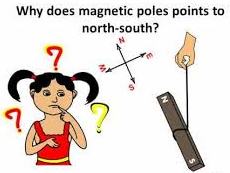Lesson Plan of Natural and Artificial Magnets General Science Grade IV
Lesson Plan of Natural and Artificial Magnets
General Science Grade IV
Students’ Learning Outcomes
·
Investigate using a magnet
that some materials are “magnetic” and some are “nonmagnetic”
·
Recognize that a magnet has
two poles.
Information for Teachers
·
Magnetic materials are those
which are attracted by the magnet.
·
Non-magnetic materials are
those which are not attracted by the magnet.
·
A magnet has two poles. One is
called the North Pole and the other is called South Pole.
·
The magnet effect of a magnet
is the strongest at the poles.
Material / Resources
Bar magnets, pencils, steel clips, pieces of
wood, plastic objects, rulers, combs, erasers, steel nails, iron filing,
textbook
Worm up activity
·
Ask the students how many of
them have seen a magic piece of metal which attracts the iron pieces.
·
What do they call it?
·
Now show a bar magnet to the
class.
·
Demonstrate that magnet
attracts steel pins or clips.
Development
Activity 1
· Divide the students into groups.
· Give each group a bar magnet, some magnet and some non-magnetic materials.
· Ask students: Do you think a magnet will pull all types of things?
· Ask the students to test this property of magnet by bringing it near all the given objects turn by turn.
· After they have tested, ask them to identify the things which are attracted by the magnet and which are not attracted.
· Tell them that things which are attracted by the magnets are called magnetic materials and things which are not attracted by magnets are called non-magnetic materials.
· Ask the students to write the names of magnetic and non-magnetic objects in separate columns in their notebooks.
· Ask them what is common property in all the magnetic materials
Activity 2
·
Give a bar
magnet and some iron filings to each group.
·
Ask them to
place a magnet on a paper.
·
Sprinkle the
iron filings on to the bar magnet and tap the table gently.
·
Observe the
filing stuck to the bar magnet.
·
Ask the
students, are the filings evenly stuck to all parts of the magnet?
·
Disturb the
filings and repeat the process and see what happens.
·
Ask the
students questions like:
v
On which
parts of the magnet, are the iron filings mostly stuck?
(Expected answer: At their ends)
v
Why are the
iron filings stuck more at the ends?
(Expected answer: Magnet is stronger at the
ends)
v
What do you
call the ends of the magnet?
(Expected answer: Poles of the Magnet)
·
After this
discussion, inform the students that the ends of magnet are called opposite
poles and then introduce the terms of North Pole and South Pole.
Sum up / Conclusion
·
The materials
which are attracted by the magnet are called as magnetic materials
·
The materials
which are not attracted by a magnet are called non-magnetic materials.
·
Most of the
iron filings are attracted towards the ends of the magnet. These ends are
called poles.
·
There are
two poles of a magnet. One is the North Pole and other is the South Pole.
Assessment
·
Make a
table on the board and ask them to copy it in their notebooks.
·
Divide the
students into groups.
·
Provide each
group the materials given in the table.
·
Ask the
students to predict, without using the magnet or not and then record their
observations in the table. Instruct them put a tick in the right column.
·
Provide each
group a magnet and instruct them to test the objects and record their
observations in the given table.
Sr. no.
|
Materials
|
Prediction
|
Result
|
||
Will be attracted by magnet
|
Will not be attracted by magnet
|
Attracted by magnet
|
Not attracted by magnet
|
||
Wooden Strip
|
|||||
Iron nail
|
|||||
Coin
|
|||||
Plastic ruler
|
|||||
Steel ruler
|
|||||
Cotton
|
|||||
Pencil
|
|||||
Paper clips
|
|||||
Brass wire
|
|||||
Copper wire
|
|||||
Follow up
·
Prepare a
list of magnetic and non-magnetic materials present at your home or
surroundings other than discussed in the classroom.






Comments
Post a Comment